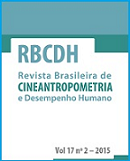Aspectos da flexibilidade de mulheres com síndrome de fibromialgia
DOI:
https://doi.org/10.1590/1980-0037.2015v17n2p238Resumo
Exercícios físicos em mulheres com síndrome de fibromialgia (SFM) têm apresentado efeitos na força e potência aeróbica, contudo, os resultados acerca da flexibilidade têm sido controversos. Além disso, os estudos têm avaliado articulações específicas ou testes que envolvam apenas um único movimento corporal. Objetivou-se comparar o perfil de flexibilidade global de mulheres acometidas pela SFM e assintomáticas a partir de um protocolo de teste mais abrangente quanto ao número de movimentos e articulações envolvidas. Participaram da pesquisa 30 mulheres divididas em dois grupos: assintomáticas (n = 15; 50,2 ± 8,2 anos; 63,0 ± 9,6 kg; 157 ± 6 cm) e fibromiálgicas (n = 15; 47,3 ± 9,4 anos; 61,9 ± 12,2 kg; 159 ± 7 cm). A flexibilidade medida pelo Flexiteste foi avaliada pelo índice global de flexibilidade (flexíndice) e pelos cinco índices de variabilidade da mobilidade articular: intermovimentos (IVIM), intra-articulação (IVIA), flexão-extensão (IVFE), entre segmentos (IVES) e distal-proximal (IVDP). Todos os índices foram calculados com base nos resultados dos 20 movimentos do flexiteste. Não houve diferença no flexíndice entre os grupos (44,4 ± 3,7 vs 45,7 ± 4,1 pontos, para assintomáticas e fibromiálgicas respectivamente; p=0,379; IC95% = -4,2 a 1,6). A maioria da amostra (83%) apresentou nível de flexibilidade considerado na média da população para o gênero feminino e para cada faixa etária específica. Entre os índices de variabilidade da mobilidade articular apenas o IVIM apresentou diferença significativa. Mulheres assintomáticas e fibromiálgicas apresentam níveis globais de flexibilidade similares, mas com perfis diferentes.
Downloads
Publicado
Edição
Seção
Licença

Direitos Autorais para artigos publicados nesta revista são do autor, com direitos de primeira publicação para a revista. Em virtude da aparecerem nesta revista de acesso público, os artigos são de uso gratuito, com atribuições próprias, em aplicações educacionais e não-comerciais, desde que seja dada a atribuição. Esta obra foi licenciada com uma Licença Creative Commons Atribuição 4.0 Internacional - CC BY


